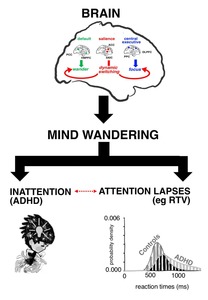Tan, Kai Syng 
Abstract
A new hypothesis relating ADHD and mind wandering, was published as a journal article 'Mind wandering perspective on attention-deficit/hyperactivity disorder'. This was in the Neuroscience & Biobehavioral Reviews journal, a peer-reviewed scientific journal covering behavioral neuroscience published by Elsevier (impact factor 8.002, 2018). The journal publishes reviews, theoretical articles, and mini-reviews. It is an official journal of the International Behavioral Neuroscience Society. This article is important because they are a paradigm shift from previous thinking, The lead author, neuroscientist Natali S. Bozhilova, commissioned Kai to create an accompanying diagram to explain this shift in thinking. https://doi.org/10.1016/j.neubiorev.2018.07.010 Attention-Deficit/Hyperactivity Disorder (ADHD) is a common neurodevelopmental disorder associated with a range of mental health, neurocognitive and functional problems. Although the diagnosis is based on descriptions of behaviour, individuals with ADHD characteristically describe excessive spontaneous mind wandering (MW). MW in individuals with ADHD reflects constant mental activity which lacks topic stability and content consistency. Based on this review of the neural correlates of ADHD and MW, we outline a new perspective on ADHD: the MW hypothesis. We propose that altered deactivation of the default mode network, and dysfunctional interaction with the executive control network, leads to excessive and spontaneous MW, which underpins symptoms and impairments of ADHD. We highlight that processes linked to the normal neural regulation of MW (context regulation, sensory decoupling, salience thresholds) are deficient in ADHD. MW-related measures could serve as markers of the disease process, as MW can be experimentally manipulated, as well as measured using rating scales, and experience sampling during both cognitive tasks and daily life. MW may therefore be a potential endophenotype.
Repository staff only
 |
Edit record |


![[img]](https://e-space.mmu.ac.uk/624620/1.hassmallThumbnailVersion/MindWandering_Neuroscience_Bozhilova_Asherson_.jpeg)